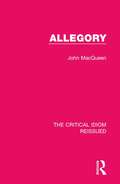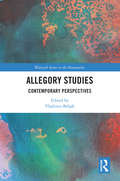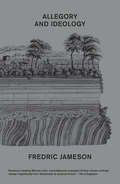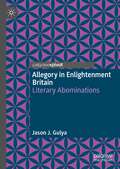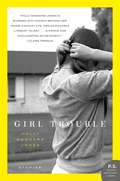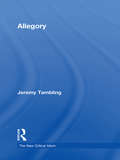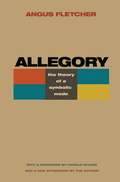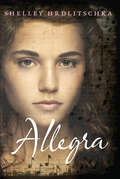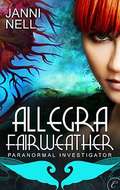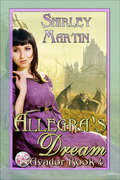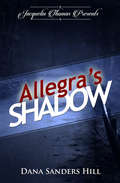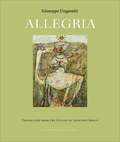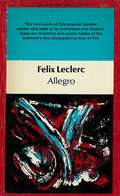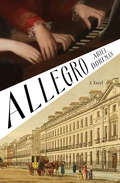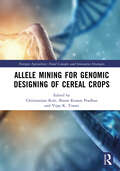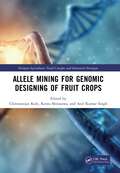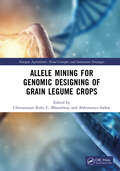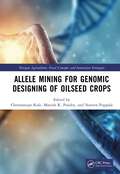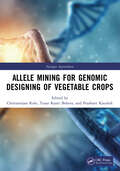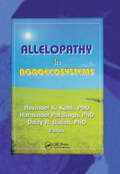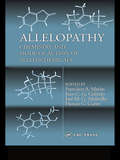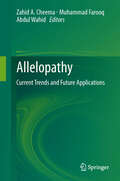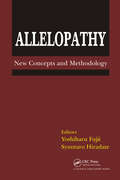- Table View
- List View
Allegory (The Critical Idiom Reissued #13)
by John MacQueenFirst published in 1970, this book examines the use of allegory in religious, philosophical and literary texts. It traces the development of the device over time from the Classical period through to the early modern and modern periods, demonstrating its evolution from the transmission of myths and religious beliefs to a literary device.
Allegory Studies: Contemporary Perspectives (Warwick Series in the Humanities)
by Vladimir BrljakAllegory Studies: Contemporary Perspectives collects some of the most compelling current work in allegory studies, by an international team of researchers in a range of disciplines and specializations in the humanities and cognitive sciences. The volume tracks the subject across established disciplinary, cultural, and period-based divides, from its shadowy origins to its uncertain future, and from the rich variety of its cultural and artistic manifestations to its deep cognitive roots. Allegory is everything we already know it to be: a mode of literary and artistic composition, and a religious as well as secular interpretive practice. As the volume attests, however, it is much more than that—much more than a sum of its parts. Collectively, the phenomena we now subsume under this term comprise a dynamic cultural force which has left a deep imprint on our history, whose full impact we are only beginning to comprehend, and which therefore demands precisely such dedicated cross-disciplinary examination as this book seeks to provide.
Allegory and Ideology
by Fredric JamesonFredric Jameson takes on the allegorical formWorks do not have meanings, they soak up meanings: a work is a machine for libidinal investments (including the political kind). It is a process that sorts incommensurabilities and registers contradictions (which is not the same as solving them!) The inevitable and welcome conflict of interpretations - a discursive, ideological struggle - therefore needs to be supplemented by an account of this simultaneous processing of multiple meanings, rather than an abandonment to liberal pluralisms and tolerant (or intolerant) relativisms. This is not a book about "method", but it does propose a dialectic capable of holding together in one breath the heterogeneities that reflect our biological individualities, our submersion in collective history and class struggle, and our alienation to a disembodied new world of information and abstraction. Eschewing the arid secularities of philosophy, Walter Benjamin once recommended the alternative of the rich figurality of an older theology; in that spirit we here return to the antiquated Ptolemaic systems of ancient allegory and its multiple levels (a proposal first sketched out in The Political Unconscious); it is tested against the epic complexities of the overtly allegorical works of Dante, Spenser and the Goethe of Faust II, as well as symphonic form in music, and the structure of the novel, postmodern as well as Third-World: about which a notorious essay on National Allegory is here reprinted with a theoretical commentary; and an allegorical history of emotion is meanwhile rehearsed from its contemporary, geopolitical context.
Allegory in Enlightenment Britain: Literary Abominations
by Jason J. GulyaThis Palgrave Pivot argues for the significance of allegory in Enlightenment writing. While eighteenth-century allegory has often been dismissed as an inadequate form, both in its time and in later scholarship, this short book reveals how Enlightenment writers adapted allegory to the cultural changes of the time. It examines how these writers analyzed earlier allegories with scientific precision and broke up allegory into parts to combine it with other genres. These experimentations in allegory reflected the effects of empiricism, secularization and a modern aesthetic that were transforming Enlightenment culture. Using a broad range of examples – including classics of the genre, eighteenth-century texts and periodicals – this book argues that the eighteenth century helped make allegory the flexible, protean literary form it is today.
Allegory of a Cave
by Holly Goddard JonesIn Girl Trouble, acclaimed writer Holly Goddard Jones examines small-town Southerners aching to be good, even as they live in doubt about what goodness is. A high school basketball coach learns that his star player is pregnant--with his child. A lonely woman reflects on her failed marriage and the single act of violence, years buried, that brought about its destruction. In these eight beautifully written, achingly poignant, and occasionally heartbreaking stories, the fine line between right and wrong, good and bad, love and violence is walked over and over again. In "Good Girl," a depressed widower is forced to decide between the love of a good woman and the love of his own deeply flawed son. In another part of town and another time, thirteen-year-old Ellen, the central figure of "Theory of Realty," is discovering the menaces of being "at that age": too old for the dolls of her girlhood, too young to understand the weaknesses of the adults who surround her. The linked stories "Parts" and "Proof of God" offer distinct but equally correct versions of a brutal crime--one from the perspective of the victim's mother, one from the killer's. Written with extraordinary empathy and maturity, and with the breadth and complexity of a novel, Jones's stories shed light on the darkness of the human condition.
Allegory: Allegory And Literature Of The City (The New Critical Idiom)
by Jeremy TamblingIndispensable to an understanding of Medieval and Renaissance texts and a topic of controversy for the Romantic poets, allegory remains a site for debate and controversy in the twenty-first-century. In this useful guide, Jeremy Tambling: presents a concise history of allegory, providing numerous examples from Medieval forms to the present day considers the relationship between allegory and symbolism analyses the use of allegory in modernist debate and deconstruction, looking at critics such as Walter Benjamin and Paul de Man provides a full glossary of technical terms and suggestions for further reading. Allegory offers an accessible, clear introduction to the history and use of this complex literary device. It is the ideal tool for all those seeking a greater understanding of texts that make use of allegory and of the significance of allegorical thinking to literature.
Allegory: The Theory of a Symbolic Mode
by Angus FletcherAnyone who has ever said one thing and meant another has spoken in the mode of allegory. The allegorical expression of ideas pervades literature, art, music, religion, politics, business, and advertising. But how does allegory really work and how should we understand it? For more than forty years, Angus Fletcher's classic book has provided an answer that is still unsurpassed for its comprehensiveness, brilliance, and eloquence. With a preface by Harold Bloom and a substantial new afterword by the author, this edition reintroduces this essential text to a new generation of students and scholars of literature and art.Allegory puts forward a basic theory of allegory as a symbolic mode, shows how it expresses fundamental emotional and cognitive drives, and relates it to a wide variety of aesthetic devices. Revealing the immense richness of the allegorical tradition, the book demonstrates how allegory works in literature and art, as well as everyday speech, sales pitches, and religious and political appeals.In his new afterword, Fletcher documents the rise of a disturbing new type of allegory--allegory without ideas.
Allegra
by Shelley HrdlitschkaAllegra thinks being at a performing-arts high school will change her life and make her a better dancer. But high school is still high school, complete with cliques, competition and cruelty. Allegra's refuge comes in the form of a class she doesn't want to take—music theory, taught by a very young, very attractive male teacher. Soon all Allegra can think about is music composition—and Mr. Rochelli. But has she misunderstood his attention, or is he really her soul mate?
Allegra Fairweather: Paranormal Investigator
by Janni NellAllegra Fairweather here. Paranormal investigator. Got problems with specters? Shapeshifters? I'm the woman to call. Just don't call me a Ghostbuster. The last guy who did that ended up flat on his back with my boot at his throat. With my 99. 5% success rate, solving the mystery of a bleeding rose that has sprung up on the shores of Loch Furness should have been an easy gig. But already I've heard the shriek of the local banshee, discovered two bodies (and then lost two bodies), and had a near-death encounter with a three-hundred-year-old ghost. And perhaps most dangerous of all, the hot pub owner who hired me now wants to show me exactly what's under his kilt. Luckily, I'm ably assisted by my very own guardian angel. I'm grateful for his help-but he's also drop-dead gorgeous. A bit distracting when I've got a mystery to solve, and the clock is ticking. . .
Allegra's Dream (Avador #4)
by Shirley MartinUsed as a pawn for much of her life, Allegra vows that someday she will determine her own fate. But when Rowan Leinster becomes her guardian, she fears she has gone from bad to worse. ... When a handsome king seeks Allegra's hand in marriage, she must choose between the needs of her country and the desires of her heart.
Allegra's Shadow
by Dana Sanders HillWhen Mariah St. Cloud becomes a full-fledged member of the walking wounded, she shuts down. She’s learned that men are born heartbreakers, so the biology professor makes work her lover instead. It’s dependable and won’t leave the toilet seat up. But the untimely death of her beautiful, estranged sister Allegra kicks Mariah’s predictable life to the curb, and brings ex-cop Anthony Caine into her everyday existence – intense, protective and far too handsome for her self-imposed celibacy. Conflict is inevitable. Anthony wants to tumble Mariah’s reserve like the walls of Jericho and keep her safe. Mariah just wants him out of her hair – even as she stands in the deadly shadow of Allegra’s secrets.
Allegria
by Giuseppe UngarettiGeoffrey Brock, whose translations have won him Poetry magazine's John Frederick Nims Memorial Prize and a Guggenheim Fellowship, finally does justice to these slim, concentrated verses in his English translation, alongside Ungaretti's Italian originals.Famed for his brevity, Giuseppe Ungaretti's early poems swing nimbly from the coarse matter of tram wires, alleyways, quails in bushes, and hotel landladies to the mystic shiver of pure abstraction. These are the kinds of poems that, through their numinous clarity and shifting intimations, can make a poetry-lover of the most stone-faced non-believer. Ungaretti won multiple prizes for his poetry, including the 1970 Neustadt International Prize for Literature. He was a major proponent of the Hermetic style, which proposed a poetry in which the sounds of words were of equal import to their meanings. This auditory awareness echoes through Brock's hair-raising translations, where a man holding vigil with his dead, open-mouthed comrade, says, "I have never felt / so fastened / to life."
Allegro
by Adora BennettThe only African American vice president at one of Boston's hottest ad agencies, Jada Green is at the top of her game. She's 45 and single, but she's living life to the fullest. Luca Alessandri, the strikingly handsome president of Allegro, an Italian commercial design firm, is looking for an ad agency to help craft his company's image in the US. When they meet, they are both thrown off balance by their instant attraction. Jada knows there can only be trouble getting involved with a potential client, so she faces a real dilemma when Luca starts pursuing her with a vengeance. Their romance takes them from Boston to the Alpine beauty of Torino, Italy and back again as they learn about each other and struggle to balance their careers, friendships, jealousies ...and threats from vengeful colleagues.
Allegro
by Adora BennettThe only African American vice president at one of Boston's hottest ad agencies, Jada Green is at the top of her game. She's 45 and single, but she's living life to the fullest.Luca Alessandri, the strikingly handsome president of Allegro, an Italian commercial design firm, is looking for an ad agency to help craft his company's image in the US. When they meet, they are both thrown off balance by their instant attraction.Jada knows there can only be trouble getting involved with a potential client, so she faces a real dilemma when Luca starts pursuing her with a vengeance.Their romance takes them from Boston to the Alpine beauty of Torino, Italy and back again as they learn about each other and struggle to balance their careers, friendships, jealousies ...and threats from vengeful colleagues.
Allegro: A Novel
by Ariel DorfmanThis thrilling historical mystery starring Mozart tells of friendship and betrayal, and how music allows us to defy death—from the acclaimed author of Death and the Maiden and The Suicide Museum.In 1789 Wolfgang Amadeus Mozart visits the grave of Johann Sebastian Bach in Leipzig, looking for a sign, a signal, an answer to an enigma that has haunted him since childhood: Was Bach murdered by a famous oculist? And years later, was Handel a victim of the same doctor?Allegro follows his investigation, from the salons of London to the streets of Paris, recreating an enthralling and turbulent time, full of rogues and brilliant composers, charlatans and presumptuous nobles. Running parallel to this search is the rise of Mozart, his knowledge and fame, his trials and losses.
Allele Mining for Genomic Designing of Cereal Crops (Nextgen Agriculture)
by Chittaranjan Kole Sharat Kumar Pradhan Vijay K TiwariThis book deliberates on the concept, strategies, tools, and techniques of allele mining in cereal crops and its application potential in genome elucidation and improvement, including studying allele evolution, discovery of superior alleles, discerning new haplotypes, assessment of intra- and interspecific similarity, and studies of gene expression and gene prediction. Available gene pools in global germplasm collections specifically consisting of wild allied species and local landraces for almost all major crops have facilitated allele mining. Development of advanced genomic techniques including PCR-based allele priming and Eco-TILLING-based allele mining are being widely used now for mining superior alleles. Allele's discovery has become more relevant now for employing molecular breeding to develop designed crop varieties matching consumer needs and with genome plasticity to adapt the climate change scenarios. All these concepts and strategies along with precise success stories are presented in the chapters dedicated to the major cereal crops. The first book on the novel strategy of allele mining in cereal crops for precise breeding Presents genomic strategies for mining superior alleles underlying agronomic traits from genomic resources Depicts case studies of PCR-based allele priming and Eco-Tilling-based allele mining Elaborates on gene discovery and gene prediction in major cereal crops This book will be useful to the students and faculties in various plant science disciplines including genetics, genomics, molecular breeding, agronomy, and bioinformatics; the scientists in seed industries; and the policymakers and funding agencies interested in crop improvement.
Allele Mining for Genomic Designing of Fruit Crops (Nextgen Agriculture)
by Chittaranjan Kole Anil Kumar Singh Kenta ShirasawaThis book deliberates on the concept, strategies, tools, and techniques of allele mining in fruit crops and its application potential in genome elucidation and improvement including studying allele evolution, discovery of superior alleles, discerning new haplotypes, assessment of intra- and interspecific similarity, and also studies of gene expression and gene prediction. Available gene pools in global germplasm collections specifically consisting of wild allied species and local landraces for almost all major crops have facilitated allele mining. Advanced genomic techniques have been developed including PCR-based allele priming and Eco-TILLING-based allele mining that are being widely used now for mining superior alleles. Allele discovery has become more relevant now for employing molecular breeding to develop designed crop varieties matching with consumer needs and also with genome plasticity to adapt the climate change scenarios. All these concepts and strategies along with precise success stories are presented over the chapters dedicated to the major fruit crops.The features of this book are as follows: The first book on the novel strategy of allele mining in fruit crops for precise breeding Presents genomic strategies of mining superior alleles underlying agronomic traits from genomic resources Depicts case studies of PCR-based allele priming and Eco-TILLING-based allele mining Elaborates on gene discovery and gene prediction in major fruit crops This book will be useful to students and faculties in various plant science disciplines including genetics, genomics, molecular breeding, agronomy, and bioinformatics; scientists in seed industries; and also policy makers and funding agencies interested in crop improvement.
Allele Mining for Genomic Designing of Grain Legume Crops (Nextgen Agriculture)
by Chittaranjan Kole C. Bharadwaj Abhimanyu SarkarThis book deliberates on the concept, strategies, tools, and techniques of allele mining in grain legume crops and its application potential in genome elucidation and improvement, including studying allele evolution, discovery of superior alleles, discerning new haplotypes, assessment of intra- and interspecific similarity, and also studies of gene expression and gene prediction. Available gene pools in global germplasm collections specifically consisting of wild allied species and local landraces for almost all major crops have facilitated allele mining. Development of advanced genomic techniques, including PCR-based allele priming and EcoTILLING-based allele mining, is being widely used now for mining superior alleles. Allele's discovery has become more relevant now for employing molecular breeding to develop designed crop varieties matching consumer needs, and also with genome plasticity to adapt to climate change scenarios. All these concepts and strategies, along with precise success stories, are presented in the chapters dedicated to the major grain legume crops.1. The first book on the novel strategy of allele mining in grain legume crops for precise breeding.2. Presents genomic strategies for mining superior alleles underlying agronomic traits from genomic resources.3. Depicts case studies of PCR-based allele priming and EcoTILLING-based allele mining.4. Elaborates on gene discovery and gene prediction in major grain legume crops.This book will be useful to students and faculties in various plant science disciplines, including genetics, genomics, molecular breeding, agronomy, and bioinformatics; to scientists in seed industries; and also to policymakers and funding agencies interested in crop improvement.
Allele Mining for Genomic Designing of Oilseed Crops (Nextgen Agriculture)
by Chittaranjan Kole Manish K. Pandey Naveen PuppalaThis book deliberates on the concept, strategies, tools, and techniques of allele mining in oilseed crops and its application potential in genome elucidation and improvement, including studying allele evolution, discovery of superior alleles, discerning new haplotypes, assessment of intra- and interspecific similarity, and studies of gene expression and gene prediction. Available gene pools in global germplasm collections, specifically consisting of wild allied species and local landraces for almost all major crops, have facilitated allele mining. The development of advanced genomic techniques, including PCR-based allele priming and Eco-TILLING-based allele mining, is now widely used for mining superior alleles. Allele's discovery has become more relevant now for employing molecular breeding to develop designed crop varieties matching consumer needs and with genome plasticity to adapt to climate change scenarios. All these concepts and strategies, along with precise success stories, are presented in the chapters dedicated to the major oilseed crops.1. This is the first book on the novel strategy of allele mining in oilseed crops for precise breeding.2. This book presents genomic strategies for mining superior alleles underlying agronomic traits from genomic resources.3. This book depicts case studies of PCR-based allele priming and Eco-TILLING based allele mining.4. This book elaborates on gene discovery and gene prediction in major oilseed crops.This book will be useful to students and faculties in various plant science disciplines, including genetics, genomics, molecular breeding, agronomy, and bioinformatics; scientists in seed industries; and policymakers and funding agencies interested in crop improvement.
Allele Mining for Genomic Designing of Vegetable Crops (Nextgen Agriculture)
by Chittaranjan Kole Tusar Kanti Behera Prashant KaushikThis book deliberates on the concept, strategies, tools, and techniques of allele mining in vegetable crops and its application potential in genome elucidation and improvement including studying allele evolution, discovery of superior alleles, discerning new haplotypes, assessment of intra- and interspecific similarity, and studies of gene expression and gene prediction. Available gene pools in global germplasm collections specifically consisting of wild allied species and local landraces for almost all major crops have facilitated allele mining. Development of advanced genomic techniques including PCR-based allele priming and Eco-TILLING based allele mining are being widely used now for mining superior alleles. Allele's discovery has become more relevant now for employing molecular breeding to develop designed crop varieties matching consumer needs and with genome plasticity to adapt the climate change scenarios. All these concepts and strategies along with precise success stories are presented in the chapters dedicated to the major vegetable crops. The first book on the novel strategy of allele mining in vegetable crops for precise breeding Presents genomic strategies for mining superior alleles underlying agronomic traits from genomic resources Depicts case studies of PCR-based allele priming and Eco-TILLING based allele mining Elaborates on gene discovery and gene prediction in major vegetable crops This book will be useful to the students and faculties in various plant science disciplines including genetics, genomics, molecular breeding, agronomy, and bioinformatics; the scientists in seed industries; and, the policymakers and funding agencies interested in crop improvement.
Allelopathy in Agroecosystems
by Ravinder Kumar Kohli Harminder Pal Singh Daizy Rani BatishDiscover environmentally safe ways to control weeds and pests!Until now farmers have had to choose between using expensive herbicides and fertilizers, which pollute the water table, or watching crop yields drop. All too often, crop yields dropped anyway, despite intensive farming. Allelopathy in Agroecosystems offers fresh hope. It provides an in-depth understanding of allelopathy-the mysterious, complex biochemical interactions among plants and microbes. This little-understood phenomenon plays a large role in agriculture, for good or ill. It can lead to changes in nutrient dynamics, vegetation structure, and species diversity.This comprehensive treatise is the first compendium devoted to explaining and exploring these chemical interactions in agricultural crop systems. Allelopathy in Agroecosystems explains how these interactions can make soil “sick,” especially in intensively cropped areas. This leads to less growth and lower yield. On the other hand, it has great potential as an environmentally safe method of weed and pest management. The fascinating original research presented here will help you understand the complexities of this invisible yet potent force in agriculture.Allelopathy in Agroecosystems examines this interaction as it affects the most important concerns of farmers and agronomists, including: beneficial interactions between crops weed control using crop residues crop rotation natural herbicides genetic engineering soil rhizosphere bacteria improving pastures forest/crop interactions sustainable management of agroecosystems new directions for research International in scope, Allelopathy in Agroecosystems offers an abundance of scientific data on this revolutionary new concept. It offers incalculable potential for rescuing farmed-out land, increasing crop yields, and cutting back on expensive soil additives. Every agronomist, environmental scientist, policymaker, agricultural librarian, and advocate of sustainable farming needs this book.
Allelopathy: Chemistry and Mode of Action of Allelochemicals
by Francisco A. Macías Juan C. G. Galindo José M. G. Molinillo Horace G. CutlerMost, if not all, books on allelopathy cover the ecological, agronomic, and descriptive physiological aspects. And although the amount of papers published on the chemical aspects and mode of action of these compounds continues to rise, there has been, until now, no book available that reflects the latest literature. Written by experts, Allelopathy:
Allelopathy: Current Trends and Future Applications
by Muhammad Farooq Abdul Wahid Zahid A. CheemaAllelopathy is an ecological phenomenon by which plants release organic chemicals (allelochemicals) into the environment influencing the growth and survival of other organisms. In this book, leading scientists in the field synthesize latest developments in allelopathy research with a special emphasis on its application in sustainable agriculture. The following topics are highlighted: Ecological implications, such as the role of allelopathy during the invasion of alien plant species; regional experiences with the application of allelopathy in agricultural systems and pest management; the use of microscopy for modeling allelopathy; allelopathy and abiotic stress tolerance; host allelopathy and arbuscular mycorrhizal fungi; allelopathic interaction with plant nutrition; and the molecular mechanisms of allelopathy. This book is an invaluable source of information for scientists, teachers and advanced students in the fields of plant physiology, agriculture, ecology, environmental sciences, and molecular biology.
Allelopathy: New Concepts & Methodology
by Yoshiharu Fujii Syuntaro HiradateThe principal goal of allelopathy is to foster sustainable agriculture, forestry, and environment. The objective is to minimize the industrial chemicals and to maximize the use of natural resources locally available while improving crop productivity, forestry and the environment. The technological advances made in allelopathy research in recent years have been created, analyzed, and developed by scientific establishments throughout the world. They present exciting and intellectually challenging problems which are solvable using modern techniques. These modern and advanced techniques as described in the chapters presented in this volume are representative of the exciting research and development approaches today.
